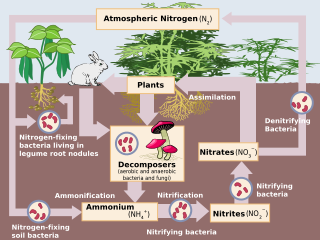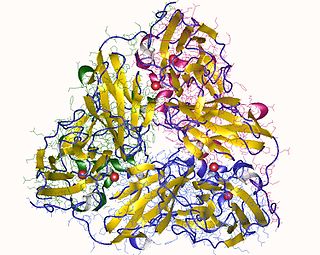
Hydroxylamine is an inorganic compound with the formula NH2OH. The material is a white crystalline, hygroscopic compound. Hydroxylamine is almost always provided and used as an aqueous solution. It is consumed almost exclusively to produce Nylon-6. The oxidation of NH3 to hydroxylamine is a step in biological nitrification.

Nitrification is the biological oxidation of ammonia to nitrite followed by the oxidation of the nitrite to nitrate occurring through separate organisms or direct ammonia oxidation to nitrate in comammox bacteria. The transformation of ammonia to nitrite is usually the rate limiting step of nitrification. Nitrification is an important step in the nitrogen cycle in soil. Nitrification is an aerobic process performed by small groups of autotrophic bacteria and archaea.

Nitrosomonas is a genus of Gram-negative bacteria, belonging to the Betaproteobacteria. It is one of the five genera of ammonia-oxidizing bacteria and, as an obligate chemolithoautotroph, uses ammonia as an energy source and carbon dioxide as a carbon source in presence of oxygen. Nitrosomonas are important in the global biogeochemical nitrogen cycle, since they increase the bioavailability of nitrogen to plants and in the denitrification, which is important for the release of nitrous oxide, a powerful greenhouse gas. This microbe is photophobic, and usually generate a biofilm matrix, or form clumps with other microbes, to avoid light. Nitrosomonas can be divided into six lineages: the first one includes the species Nitrosomonas europea, Nitrosomonas eutropha, Nitrosomonas halophila, and Nitrosomonas mobilis. The second lineage presents the species Nitrosomonas communis, N. sp. I and N. sp. II, meanwhile the third lineage includes only Nitrosomonas nitrosa. The fourth lineage includes the species Nitrosomonas ureae and Nitrosomonas oligotropha and the fifth and sixth lineages include the species Nitrosomonas marina, N. sp. III, Nitrosomonas estuarii and Nitrosomonas cryotolerans.
Nitrite reductase refers to any of several classes of enzymes that catalyze the reduction of nitrite. There are two classes of NIR's. A multi haem enzyme reduces NO2− to a variety of products. Copper containing enzymes carry out a single electron transfer to produce nitric oxide.
Nitrifying bacteria are chemolithotrophic organisms that include species of genera such as Nitrosomonas, Nitrosococcus, Nitrobacter, Nitrospina, Nitrospira and Nitrococcus. These bacteria get their energy from the oxidation of inorganic nitrogen compounds. Types include ammonia-oxidizing bacteria (AOB) and nitrite-oxidizing bacteria (NOB). Many species of nitrifying bacteria have complex internal membrane systems that are the location for key enzymes in nitrification: ammonia monooxygenase, hydroxylamine oxidoreductase, and nitrite oxidoreductase.
Nitrate reductase (NADPH) (EC 1.7.1.3, assimilatory nitrate reductase, assimilatory reduced nicotinamide adenine dinucleotide phosphate-nitrate reductase, NADPH-nitrate reductase, assimilatory NADPH-nitrate reductase, triphosphopyridine nucleotide-nitrate reductase, NADPH:nitrate reductase, nitrate reductase (NADPH2), NADPH2:nitrate oxidoreductase) is an enzyme with systematic name nitrite:NADP+ oxidoreductase. This enzyme catalises the following chemical reaction
Nitrate reductase (NAD(P)H) (EC 1.7.1.2, assimilatory nitrate reductase, assimilatory NAD(P)H-nitrate reductase, NAD(P)H bispecific nitrate reductase, nitrate reductase (reduced nicotinamide adenine dinucleotide (phosphate)), nitrate reductase NAD(P)H, NAD(P)H-nitrate reductase, nitrate reductase [NAD(P)H2], NAD(P)H2:nitrate oxidoreductase) is an enzyme with systematic name nitrite:NAD(P)+ oxidoreductase. This enzyme catalises the following chemical reaction
Nitrate reductase (NADH) (EC 1.7.1.1, assimilatory nitrate reductase, NADH-nitrate reductase, NADH-dependent nitrate reductase, assimilatory NADH: nitrate reductase, nitrate reductase (NADH2), NADH2:nitrate oxidoreductase) is an enzyme with systematic name nitrite:NAD+ oxidoreductase. This enzyme catalyzes the following chemical reaction

In enzymology, a 3-oxoacyl-[acyl-carrier-protein] reductase (EC 1.1.1.100) is an enzyme that catalyzes the chemical reaction
In enzymology, a glycine reductase (EC 1.21.4.2) is an enzyme that catalyzes the chemical reaction
In enzymology, a carboxylate reductase (EC 1.2.99.6) is an enzyme that catalyzes the chemical reaction
In enzymology, a ferredoxin—nitrite reductase (EC 1.7.7.1) is an enzyme that catalyzes the chemical reaction
In enzymology, a glycine dehydrogenase (cytochrome) (EC 1.4.2.1) is an enzyme that catalyzes the chemical reaction
Hydroxylamine oxidoreductase (HAO) is an enzyme found in the prokaryotic genus Nitrosomonas. It plays a critically important role in the biogeochemical nitrogen cycle as part of the metabolism of ammonia-oxidizing bacteria.
In enzymology, a hydroxylamine reductase (NADH) (EC 1.7.1.10) is an enzyme that catalyzes the chemical reaction.
Nitric oxide reductase, an enzyme, catalyzes the reduction of nitric oxide (NO) to nitrous oxide (N2O). The enzyme participates in nitrogen metabolism and in the microbial defense against nitric oxide toxicity. The catalyzed reaction may be dependent on different participating small molecules: Cytochrome c (EC: 1.7.2.5, Nitric oxide reductase (cytochrome c)), NADPH (EC:1.7.1.14), or Menaquinone (EC:1.7.5.2).
In enzymology, a nitrite reductase [NAD(P)H] (EC 1.7.1.4) is an enzyme that catalyzes the chemical reaction

In enzymology, a nitrite reductase (NO-forming) (EC 1.7.2.1) is an enzyme that catalyzes the chemical reaction
Aralkylamine dehydrogenase (azurin) (EC 1.4.9.2, aromatic amine dehydrogenase, arylamine dehydrogenase, tyramine dehydrogenase) is an enzyme with the systematic name aralkylamine:azurin oxidoreductase (deaminating). This enzyme catalyses the following chemical reaction:

NADH:ubiquinone reductase (non-electrogenic) (EC 1.6.5.9, NDH-2, ubiquinone reductase, coenzyme Q reductase, dihydronicotinamide adenine dinucleotide-coenzyme Q reductase, DPNH-coenzyme Q reductase, DPNH-ubiquinone reductase, NADH-coenzyme Q oxidoreductase, NADH-coenzyme Q reductase, NADH-CoQ oxidoreductase, NADH-CoQ reductase) is an enzyme with systematic name NADH:ubiquinone oxidoreductase. This enzyme catalyses the following chemical reaction:






